The O’Higgins class cruisers were the former USS Brookyn (lead class vessel) and USS Nashville, sold to Chile under MDAP in January 1951 and in service until the 1980s. They answered similar acquisition the same year by Brazil (Barroso) and Argentina with the Belgrano class, of which the latter was sunk in teh Falklands in 1982. Both O’Higgins and Capitan Prat had relatively uneventful careers, apart important collisibs that left them powerless and needed intensive repairs. They had their electronics upgraded before transfer in 1951 and again in 1958 but they were kept in their “stock” condition until the end of their service, as the last all-guns cruisers in active service pretty much until the end of the cold war. In 1971 they were even joined by a third cruiser, Almirante Latorre, former 1945 Tre Kronor. All three were camouflaged, something rare in that era of long range radars. #coldwar #ussbrooklyn #ussnashville #ohiggins #capitanprat #cruiser #chineannavy #chileday #armadadechile
Acquisition
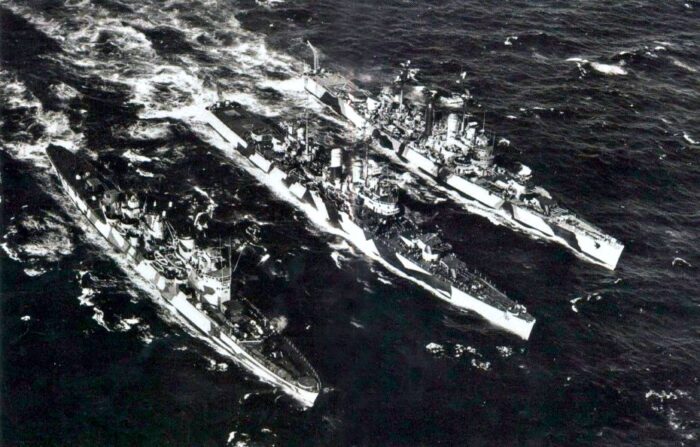
The pride of the Chilean Navy: The cruisers Latorre (ex Tre-kronor), Prat (ex-Nashville), and O’Higgins (ex-Brooklyn) sailing together for an historical photo in the 1970s src navsrource
The most spectacular acquisition of the Chilean Navy in the early cold war were a pair of Brooklyn class cruisers: O’Higgins (ex-Brooklyn) and Capitán Prat (ex-Nashville) (from 1982 Chacabuco). Albeit the design of these ships went back to 1935, they were groundbreaking for US cruiser design at the time, and had be throughly modernized in WW2. Their key feature was a battery of fifteen rapid-fire 6-in guns in three triple turrets. Both were acquired for $37m apiece (10% of the original cost) at the time she ships has been decommissioned, and a contract for transfer led to a limited refreshing overhaul. The final transfer was done on 9 January 1951. They would be active until after the Falklands war. Same type as ARA General Belgrano and Nueve de Julio, both Chile and Argentina had a pair of similar cruisers.
O’Higgins was grounded on 12.8.1974 in Patagonia fjords. Towed back to port but never fully repaired, she became an accommodation hulk, then was extensively refitted and fully recommissioned in 1978. She was decommissioned in January 1991 and sold 10.1991. Her sister did not have any improvements and was decommissioned in May 1982, and sold in April 1983. An oddity in the 1980s, O’Higgins was camouflaged.
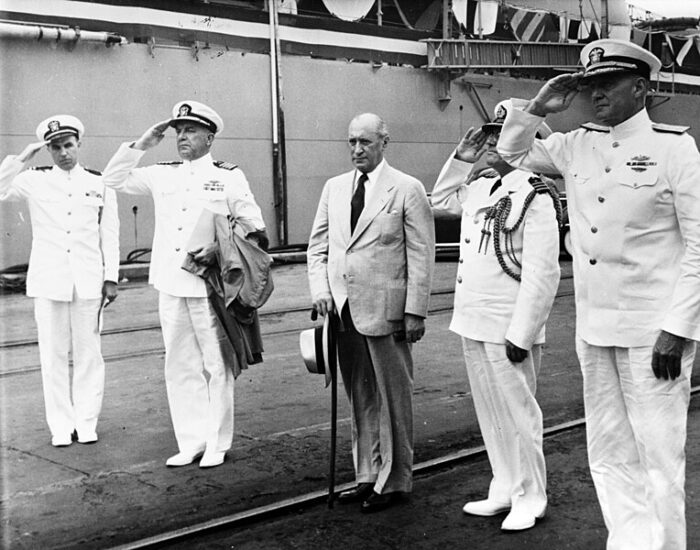
The transfer ceremony in Philadelphia, 30 June 1951
Design of the class
Being a “stock” Brooklyn class, both were transferred in the state they were decommissioned from US service. For O’Higgins this was on 3 January 1947, and stricken on 22 January 1951, actually much later than her commission date within the Chilean Navy on 9 January. As CL-40, USS Brooklyn, the namesake class lead cruiser, she was awarded 4 battle stars. Originally laid down on 12 March 1935 and launched 30 November 1936 she saw action in the Atlantic convoys, North African Campaign (Operation Torch), taking part in the Battle of Casablanca where she sank or co-claimed several French destroyers, the cruiser Primauguet and submarine Amazone. Later she took part in the Italian campaign, the Anzio-Nettuno landings in February 1944 and bombardment of the Formia-Anzio area and in August the invasion of southern France, Anvil-Dragoon. After her late 1944 overhaul she was mostly active along the eastern seaboard.
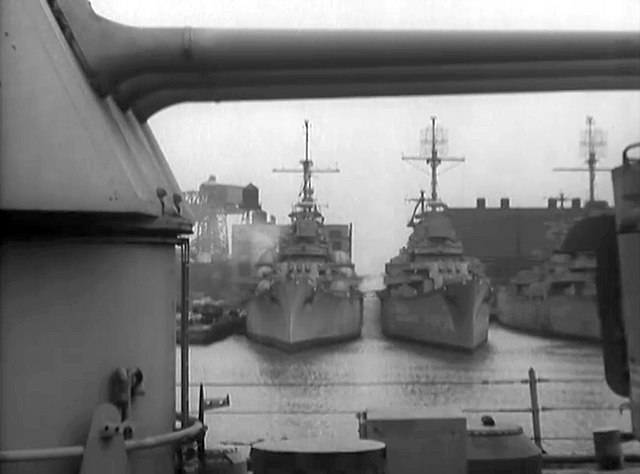
Brooklyn, Nashville and St Louis in Philadelphia, 1951
As for her sister Capitan Prat, she was the ex-USS Nashville (CL-43). Ordered in 1933 and Launched on 2 October 1937 she saw plenty of service in the interwar and WW2, escorting the Doolittle raid on Tokyo in 1942, sinking Japanese picket boats and loosing surprise. Later with Task Force 8 she took part in the Aleutians campaign, and then as flagship of TF 67 in the Guadalcanal Campaign. She then took part in many landings in the New Guinea area Dutch East Indies and Philippines Campaign, Battle of Leyte where she was hit by Kamikaze, then Borneo. When she was decommissioned 24 June 1946, she had been awarded ten battle stars, making her one of the most decorated in her class. Negociations took place in 1950 to sell her to the Chileans (Brazil and Argentina also acquired those) and she was stricken and sold to Chile the same day on 9 January 1951, becoming Capitan Prat. Each was sold at 37,000 $ apiece, 10% of their original cost.
Hull and general design
The Chilean cruisers were still in their “stock” 1945 conditions, and apart new radars, they retained intact their powerful main, secondary and AA artillery.
The Brooklyn class cruisers were quite different than their predecessors in the USN, the New Orleans and Northampton classes with a “fuller” type of hull, flush deck and ending in a transom stern. They were also the result of the 1930 London treaty, which in effect capped the number of heavy cruisers as defined by the 1922 Washington treaty (with 8 inches guns) but authorized a tonnage up to 10,000 tonnes standard. So they were “light cruisers” in name only, with a heavy cruiser hull but no less than five triple 6-inches rapid fire guns. This gave them at the time, the largest firepower of any light cruiser, on par with the Japanese Mogami class in 1934, before they were converted to 8-inches guns in 1940.
The O’Higgins class were thus 10,000 long tons (10,160 t) estimated as design and 9,767 long tons (9,924 t) standard but 12,207 long tons (12,403 t) in 1945, and as sold. Their hull measured 600 ft (180 m) overall and 608 ft 4 in (185.42 m) between perpendiculars for a beam of 61 ft 7 in (18.77 m) so 1/10 ratio and a draft between 19 ft 9 in (6.02 m) mean and 24 ft (7.3 m) max.
They had two main island structures amidships with two raked funnels and masts. The latter was modified to carry extra radars, but they remained small. The ships also retained their fire control systems, also enhanced by radars in 1945. They had a plotting table, no buried central operation, but an efficient ballistic computer. Electronics were upgraded in the 1957-59 refit in the US.
Protection
Being light cruisers, the O’Higgins class were lightly protected:
Belt: 3+1⁄4–5 in (83–127 mm)
Deck: 2 in (51 mm)
Barbettes: 6 in (150 mm)
Turrets: 1+1⁄4–6 in (32–152 mm)
Conning tower: 2+1⁄4–5 in (57–127 mm)
In addition, they had a double hull and underwater compartmentation with bulkheads, with outer compartment filled with thick fuel oil, damping the effect of a torpedo hit. This did not prevented a sinking, as shown by the fate of Belgrano in 1982.
Powerplant
The O’Higgins class cruisers kept the same powerplant without change until the end of their career. It consisted in four shaft propellers driven by four GM or Westinghouse geared steam turbines, and fed by eight Babcock and Wilcox superheated Steam boilers for a total of 100,000 shp (75,000 kW). This gave them a top speed of 32.5 knots (37.4 mph; 60.2 km/h) initially, but between their engines being work out after their WW2 service and wartime addition, 30 knots would be a safe bet. It is no known if their machinery was revised and overhauled before being sold either. It seems in their cold war career they performed well enough. Range was around 10,000 nautical miles based on 1300 tonnes fuel oil.
Armament
As delivered the cruisers kept their previous five triple turrets with 6-inches /47 Mk 16 guns, eight single 5-inches /25 Mk 27 guns and four quad 40mm/60 Mk 2 Bofors, plus six twin 40mm/60 Mark 1 and nine twin 20mm/70 Mk 24 Oerlikon AA guns. This was in 1951 still a “stock WW2 armament”. It was not a problem in the context of South American traditional rivalry, as there was no missile ship in service in either Chile, Argentina or Brazil before decades.
In 1945:
15× 6 in (150 mm)/47 caliber guns (5×3)
8× 5 in (130 mm)/25 caliber anti-aircraft guns (8×1)
4x quad and 2x twin 40 mm (1.6 in) Bofors anti-aircraft guns
18 × single 20 mm (0.79 in) Oerlikon cannons
In 1951:
They had an even large AA park, with four more twin 40 mm Bofors installed and instead of 18 single, ten (nine for Prat) twin 20 mm Oerlikon AA guns, so 20 total to gain deck space. So for the grand total, 38 Bofors, 20 Oerlikon. The Bofors were radar guided.
However this suite showed its age by the late 1950s and an agreement for modernization led to an important refit in 1957-59:
-Six quad 40mm/60 Mk 2 (2 more)
-Two twin 40mm/60 Mk 1
-Six twin 20mm/70 Mk 24
-Landing pad aft, Jet Ranger helicopter.
Sensors
More importantly, they had a relatively modern radar suite, the SPS-4, SPS-6 search radars, and the Mk 13 and two Mk 28 fire control radars.
After their refit of 1957-59 they had the SPS-10 and SPS-12 radars installed. The Fire Control Systems were unchanged.
Air Group
Oriignaly they had two catapults for a pair of Curtiss SOC Seagull spotters/recce floatplanes. They were eliminated in 1946, both the planes and catapults, leaving only the lattice axial crane and lift in the hangar below.
They were fitted in Chilean service with an helipad in 1959, pretty much like on the Belgrano class, but since this part was still lightly constructed, they could only operate a Bell Jet Ranger helicopter, usable only for liaison with the shore and between helipad-equipped ships. They were not usable as ASW helicopters.
⚙ specifications 1960 |
|
| Displacement | c12,200 long tons FL |
| Dimensions | 608 ft 4 in x 61 ft 7 in x 24 ft (185.42 x 18.77 m x 7.3 m) |
| Propulsion | 4× geared turbines, 8 × Steam boilers: 100,000 shp (75,000 kW) |
| Speed | c30 kn, 32.5 kts originally (37.4 mph; 60.2 km/h) |
| Range | Oil 1321t in 1982, 100,000 nm at 15 kts |
| Armament | 15× 6 in/47, 8× 5 in/25, 4×4 40 mm, 6×2 40 mm Bofors, 10×2 20 mm Oerlikon AA* |
| Protection | Belt 5 in, Deck 2 in, Barbettes 6 in, turrets 6 in, CT 5 in |
| Sensors | SPS-10 and SPS-12 radars, Mk 13 and two Mk 28 fire control radars |
| Air Group | 1 Bell Jet Ranger |
| Crew | 868 officers and enlisted |
*Prat had nine twin Oerlikon guns.
Career of the O’Higgins class
 O’Higgins
O’Higgins
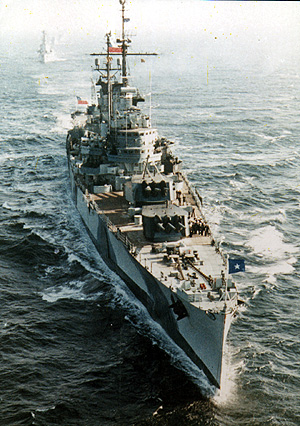 The Republic of Chile purchased USS Brooklyn for 37 million dollars after she was overhauled at Philadelphia. Chilean Navy personal took charge of the ship on June 30, 1951 in Philadelphia. Once in Chile, she became flagship of the Squadron several times, taking part in in UNITAS operations. In 1958 she underwent a modernization in the USA, mostly the installation of new radars.
The Republic of Chile purchased USS Brooklyn for 37 million dollars after she was overhauled at Philadelphia. Chilean Navy personal took charge of the ship on June 30, 1951 in Philadelphia. Once in Chile, she became flagship of the Squadron several times, taking part in in UNITAS operations. In 1958 she underwent a modernization in the USA, mostly the installation of new radars.
On July 24, 1961, while anchored in Punta Arenas Bay, a boat returning on board from the Prat dock capsized when reaching her side, killing 17 crew members, cornered by turbulence and low water temperature. Another 20 saved their lives by reaching the rafts and rope ladders deployed.
On August 12, 1974, while sailing through the Patagonian channels, O’Higgins collided with an uncharted rock, suffering heavy damage. This open a gash in her hull over 71 meters. She quickly was flooded with 2,500 tons of seawater, lost her boiler and engine rooms, and leaving her power-less. Damage Control parties controlled managed to regain just enough buoyancy, and later 65 divers were shipped there to work on patching her hull. After enough pumping she was able to sail out for full repairs in Talcahuano. Work was also done to overhaul and boilers and engines. This started by mid-September, and completed in late 1975.
O’Higgins was eventually decommissioned on September 27, 1991 by D.S. (M) N 28 of October 28, 1991,. She was placed for sale and purchased by the British Company Incom Shiptrade Ltd., transferred by contract on 2, 1992 for demolition.

 Capitan Prat
Capitan Prat
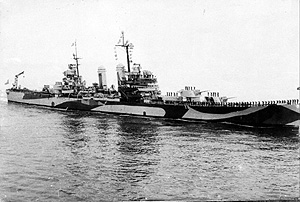 In Philadelphia, USS Nashville was reconditioned and sold to the Chilean government on January 4, 1951. She became flagship of the Squadron on several occasions. In 1957 she underwent various modernizations in the United States.
In Philadelphia, USS Nashville was reconditioned and sold to the Chilean government on January 4, 1951. She became flagship of the Squadron on several occasions. In 1957 she underwent various modernizations in the United States.
On April 1, 1971, sailing with the Squadron towards Puerto Aldea, she was accidentally rammed by the destroyer Cochrane on the port side, between the two funnel. The collision opened a two square meters gash below the waterline, flooded the boiler rooms. She was left without power and the personnel on duty joined the Damage Control party to built and secure bulkheads, pumping out water and kept the non-flooded compartments watertight. Her final repairs were carried out in Asmar Naval yard in Talcahuano.
Upon the arrival of the destroyer Captain Prat (Ex-HMS Norfolk) in 1982, her name was changed to Chacabuco, and she became a barracks ship. She was decommissioned on May 10, 1982. Her sale was authorized by D.S. (M) No. 26 of April 20, 1983. She was sold to the Canadian businessman Noel Williams Kennedy, as published on April 29, 1983, and towed to the Kaohshiung in Taiwan to be broken up. It is unsure if the Chilean proposed her to the US government to be converted as museum ship.
Significance

The two cruisers in Valparaiso, Sept. 1975
Transferred under the Mutual Defense Assistance Program (MDAP) her already light acquisition cost was partly covered by the latter. They came out cheaply, but the Chilean Navy still had to provide yearly maintenance and large crews. The choice to sell the exact same class under the same program to the prominent South American rival navies was a way to maintain control over a possible new naval arms race. This did not prevented both Brazil and Argentina to pursue for a time a nuclear program.
Unfortunately for the 1960s standards, these ships were completely obsolete. Their artillery could not stop a missile or a jet. They were seen mostly as prestige vessels, potentially usable for shore bombardments, which was handy in an always shaky political context. But they were maintained mostly because rival Argentina and Brazil kept theirs. The US plan to avoid a repeat of past naval arms race, crippling for their economies, worked. Chile at some point in 1971 had more cruisers than her rivals, with the acquisition of the ex-Swedish light cruiser Tre Kronor. In 1963 these were escorted by four destroyers, two Fletchers and two Almirante, a modern take on the postwae Battle/Daring class by Vickers armed with missiles. The O’Higgins class were replaced by large missiles ships at last in the 1980s, with four ex-County class destroyers.
Read More/Src
Links
https://web.archive.org/web/20140502013247/http://www.armada.cl/prontus_armada/site/artic/20090804/pags/20090804131107.html
https://web.archive.org/web/20140502003149/http://www.history.navy.mil/danfs/b9/brooklyn-iii.htm
https://web.archive.org/web/20140503185100/http://www.armada.cl/prontus_armada/site/artic/20090707/pags/20090707175132.html
https://en.wikipedia.org/wiki/USS_Brooklyn_(CL-40)
https://en.wikipedia.org/wiki/USS_Nashville_(CL-43)
https://es.wikipedia.org/wiki/Capit%C3%A1n_Prat_(CL-03)
https://www.navypedia.org/ships/chile/chi_cr_ohiggins51.htm
https://www.navypedia.org/ships/usa/us_cr_brooklyn.htm
https://web.archive.org/web/20140814052913/http://www.history.navy.mil/photos/sh-usn/usnsh-n/cl43.htm
http://www.ussnashville.org/USS_Nashville/Home_Port.html
http://www.mardechile.cl/index.php?option=com_content&view=article&id=1683:naufragio-en-punta-arenas&catid=72:historias-de-mar&Itemid=50
https://revistamarina.cl/revistas/2009/2/ashcroft.pdf
https://web.archive.org/web/20080408071943/http://www.history.navy.mil/photos/sh-usn/usnsh-b/cl40.htm
Videos
Model Kits
Take a standard Booklyn model !
3D
Nope



 Latest Facebook Entry -
Latest Facebook Entry -  X(Tweeter) Naval Encyclopedia's deck archive
X(Tweeter) Naval Encyclopedia's deck archive Instagram (@navalencyc)
Instagram (@navalencyc)





 French Navy
French Navy Royal Navy
Royal Navy Russian Navy
Russian Navy Armada Espanola
Armada Espanola Austrian Navy
Austrian Navy K.u.K. Kriegsmarine
K.u.K. Kriegsmarine Dansk Marine
Dansk Marine Nautiko Hellenon
Nautiko Hellenon Koninklije Marine 1870
Koninklije Marine 1870 Marinha do Brasil
Marinha do Brasil Osmanlı Donanması
Osmanlı Donanması Marina Do Peru
Marina Do Peru Marinha do Portugal
Marinha do Portugal Regia Marina 1870
Regia Marina 1870 Nihhon Kaigun 1870
Nihhon Kaigun 1870 Preußische Marine 1870
Preußische Marine 1870 Russkiy Flot 1870
Russkiy Flot 1870 Svenska marinen
Svenska marinen Søværnet
Søværnet Union Navy
Union Navy Confederate Navy
Confederate Navy Armada de Argentina
Armada de Argentina Imperial Chinese Navy
Imperial Chinese Navy Marinha do Portugal
Marinha do Portugal Mexico
Mexico Kaiserliche Marine
Kaiserliche Marine 1898 US Navy
1898 US Navy Sovietskiy Flot
Sovietskiy Flot Royal Canadian Navy
Royal Canadian Navy Royal Australian Navy
Royal Australian Navy RNZN Fleet
RNZN Fleet Chinese Navy 1937
Chinese Navy 1937 Kriegsmarine
Kriegsmarine Chilean Navy
Chilean Navy Danish Navy
Danish Navy Finnish Navy
Finnish Navy Hellenic Navy
Hellenic Navy Polish Navy
Polish Navy Romanian Navy
Romanian Navy Turkish Navy
Turkish Navy Royal Yugoslav Navy
Royal Yugoslav Navy Royal Thai Navy
Royal Thai Navy Minor Navies
Minor Navies Albania
Albania Austria
Austria Belgium
Belgium Columbia
Columbia Costa Rica
Costa Rica Cuba
Cuba Czechoslovakia
Czechoslovakia Dominican Republic
Dominican Republic Haiti
Haiti Hungary
Hungary Honduras
Honduras Estonia
Estonia Iceland
Iceland Eire
Eire Equador
Equador Iran
Iran Iraq
Iraq Latvia
Latvia Liberia
Liberia Lithuania
Lithuania Mandchukuo
Mandchukuo Morocco
Morocco Nicaragua
Nicaragua Persia
Persia San Salvador
San Salvador Sarawak
Sarawak Uruguay
Uruguay Venezuela
Venezuela Zanzibar
Zanzibar Warsaw Pact Navies
Warsaw Pact Navies Bulgaria
Bulgaria Hungary
Hungary

 Bundesmarine
Bundesmarine Dutch Navy
Dutch Navy Hellenic Navy
Hellenic Navy Marina Militare
Marina Militare Yugoslav Navy
Yugoslav Navy Chinese Navy
Chinese Navy Indian Navy
Indian Navy Indonesian Navy
Indonesian Navy JMSDF
JMSDF North Korean Navy
North Korean Navy Pakistani Navy
Pakistani Navy Philippines Navy
Philippines Navy ROKN
ROKN Rep. of Singapore Navy
Rep. of Singapore Navy Taiwanese Navy
Taiwanese Navy IDF Navy
IDF Navy Saudi Navy
Saudi Navy Royal New Zealand Navy
Royal New Zealand Navy Egyptian Navy
Egyptian Navy South African Navy
South African Navy






























 Ukrainian Navy
Ukrainian Navy dbodesign
dbodesign